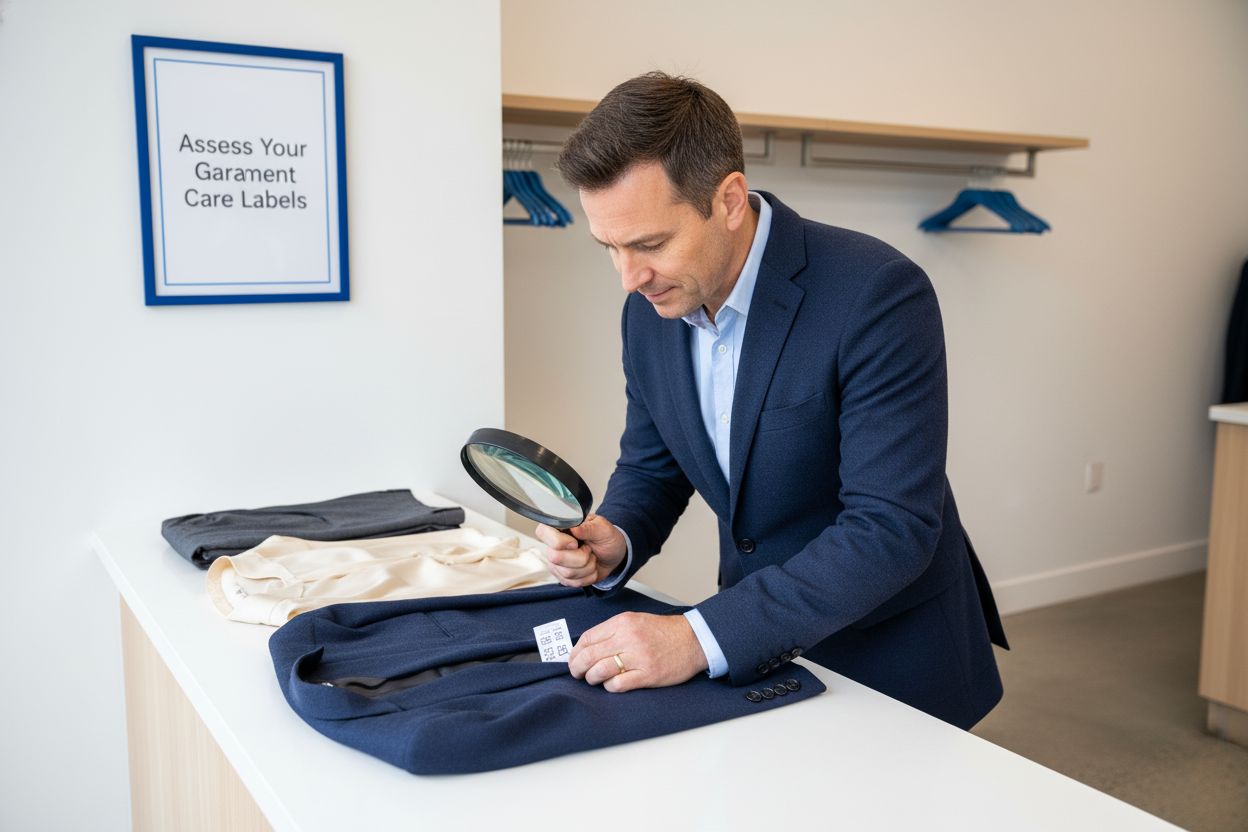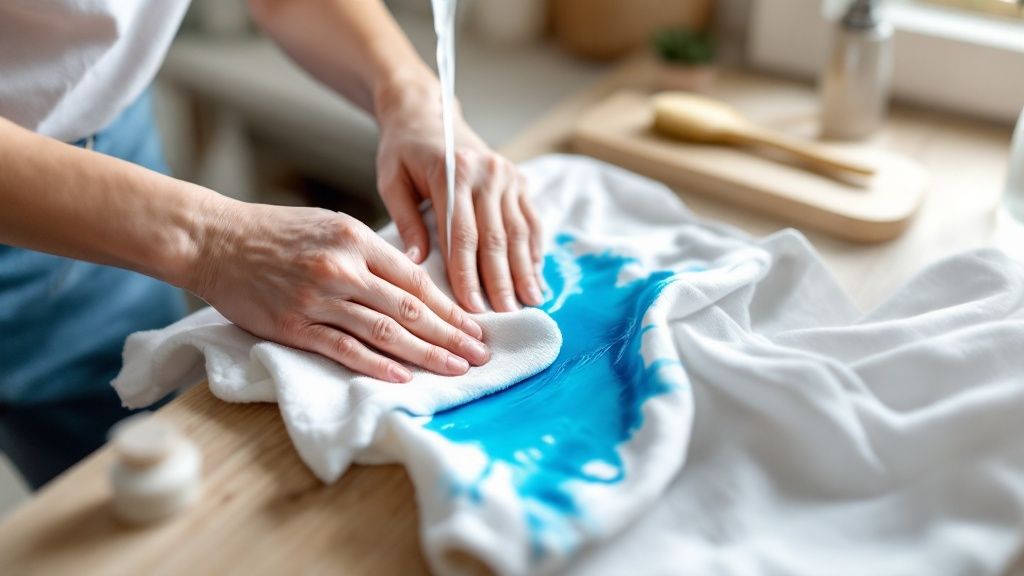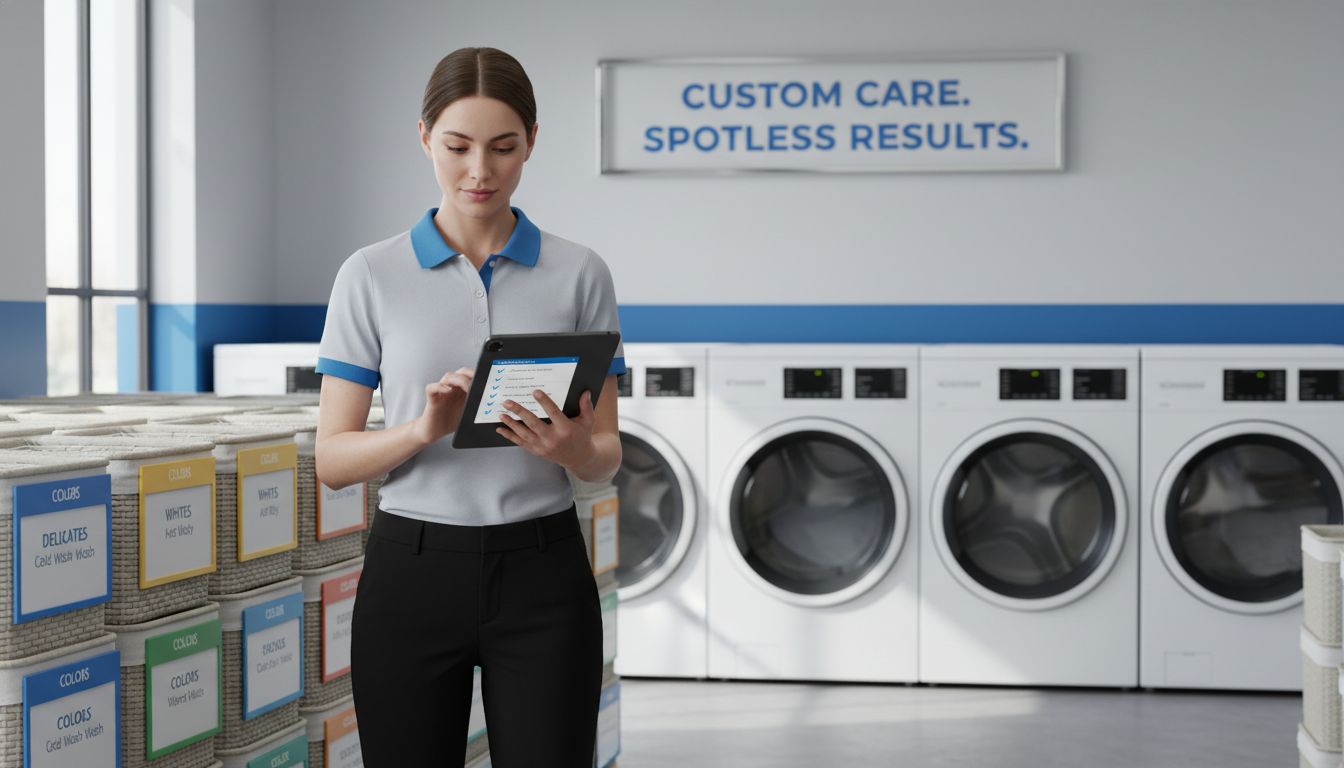Laundry Stripping Recipes to Deep Clean Fabrics
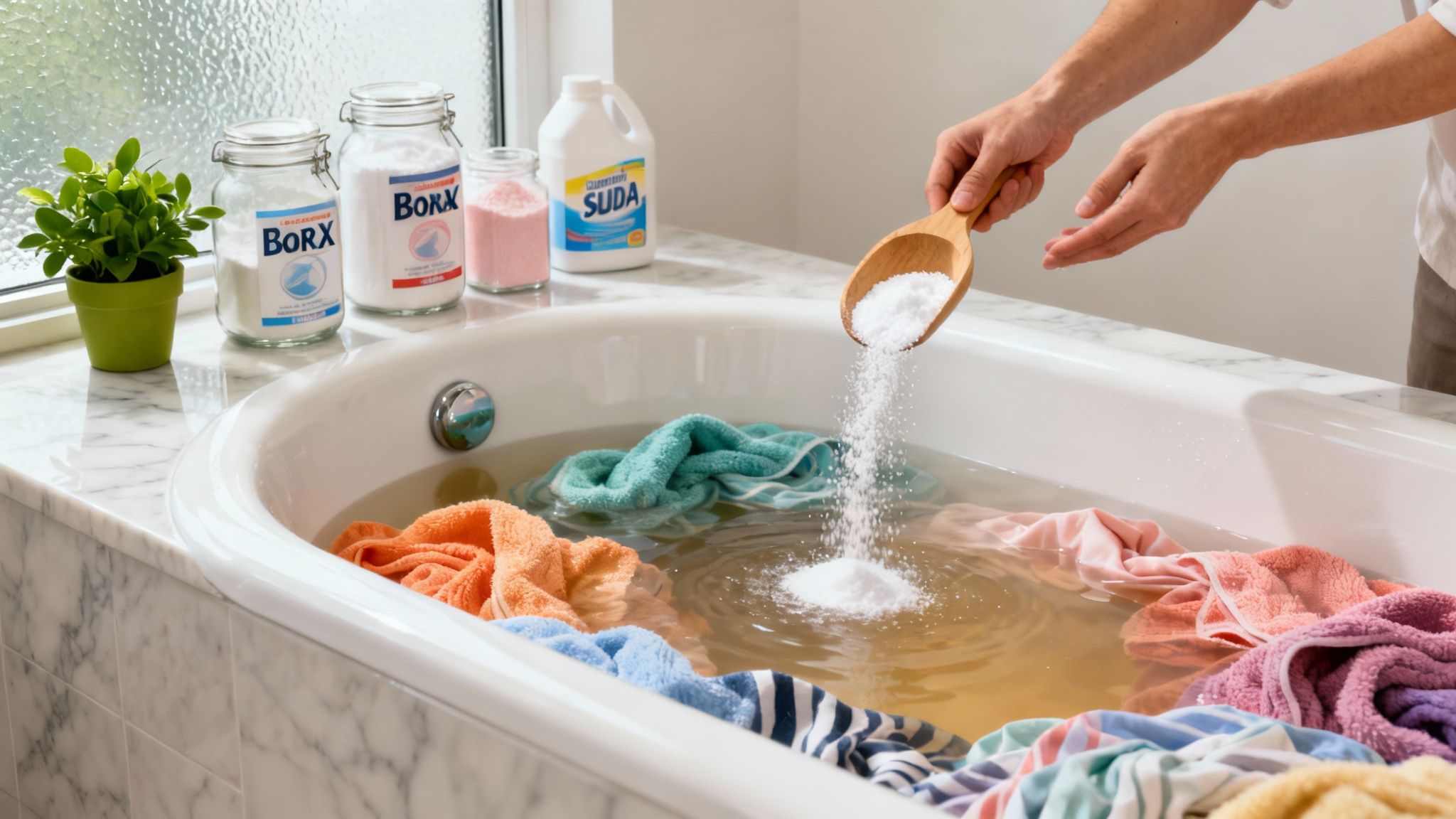
The classic laundry stripping recipes rely on a simple but seriously powerful trio: borax, washing soda, and powdered detergent. This isn't your everyday wash; this combination is specifically designed to go after the stubborn, built-up gunk—minerals, body oils, and soap residue—that regular washing just can't touch.
Think of it as a deep-cleaning reset for your fabrics.
So, What Is Laundry Stripping Actually Doing?
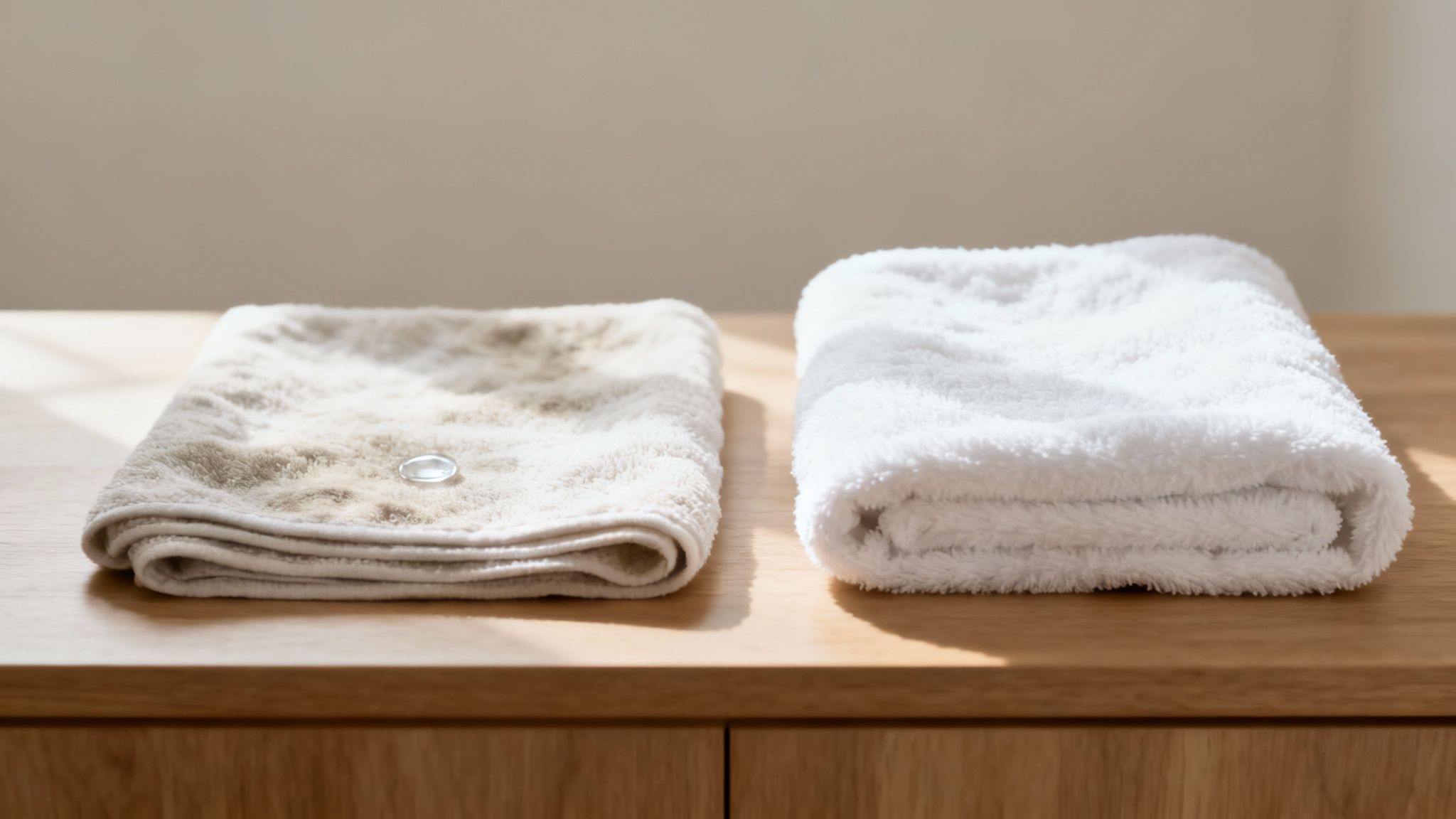
Ever pull towels from the dryer only to find they feel stiff and just don't absorb water like they used to? Or maybe your workout gear still has that faint, funky odor even after a good wash. Those are the tell-tale signs that your textiles are crying out for help. They're suffering from buildup.
Laundry stripping is really just a long, hot soak designed to pull all that trapped residue out of the fabric fibers. Over time, things like mineral deposits from hard water, body oils, sweat, and even leftover detergent and fabric softener create a film that a normal wash cycle can't break through. This is exactly what makes your fabrics feel less soft, look dull, and hold onto smells.
Why Your Laundry Needs This Deep Clean
The magic happens in the hot water. The high temperature opens up the fabric's fibers, allowing the alkaline cleaning solution to get in and dissolve all that trapped grime. The result is often some shockingly murky, gross-looking water, which is all the proof you need of what was hiding in your "clean" laundry.
This intense process hits several key problem areas at once:
- It Restores Absorbency. By getting rid of that waxy film, your towels and washcloths can finally soak up moisture effectively again.
- It Kills Lingering Odors. Instead of just masking smells, it dissolves the oils and bacteria that cause them in the first place.
- It Brightens Whites and Colors. When you strip away that dingy layer of buildup, the original vibrancy of your fabrics can shine through.
- It Softens Fabrics. Without all that stiff residue, things like bed sheets and towels feel noticeably softer against your skin.
Laundry stripping is a targeted intervention, not an everyday solution. Think of it as a biannual "factory reset" for your hardest-working textiles to bring them back to life.
If you've ever struggled with bigger items, like figuring out how to properly wash doonas to prevent the same kind of dust and sweat buildup, you'll understand why a deep clean is sometimes necessary. It’s no surprise that people are looking for more powerful cleaning solutions. The global laundry care products market was valued at USD 109.7 billion in 2024 and is expected to climb to USD 144.30 billion by 2030. That's a huge jump, and it shows a clear trend: we all want a deeper, more effective level of clean for our homes.
When to Strip Your Laundry
Not everything needs stripping, of course. Here’s a quick-reference table to help you identify which items in your home would benefit most from this kind of deep clean.
Think of stripping as a reset button. When you notice these problems popping up, it's a good sign that your regular routine isn't cutting it anymore and it's time for a more intensive approach.
The Classic Laundry Stripping Recipe Explained
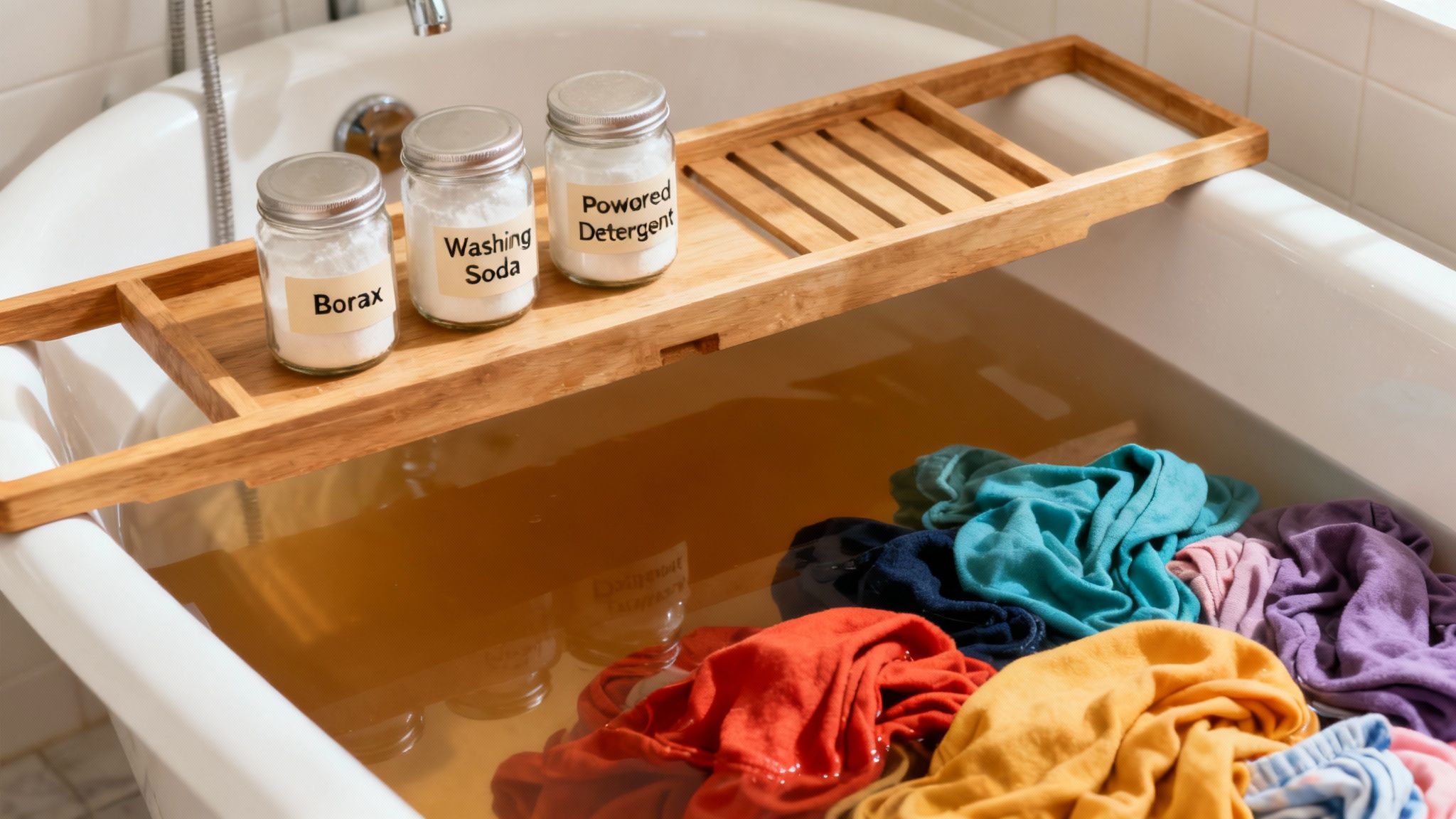
This is the one you’ve seen all over social media—the method that delivers those shockingly murky bathtub pictures. And trust me, it’s gone viral for a good reason: it really, really works.
The classic laundry stripping recipe is basically a power trio designed to attack years of hidden gunk that your regular wash cycle can't even touch. Think of it as the ultimate deep-cleanse for your hardest-working fabrics.
At its heart, the standard formula is a simple but potent mix. Most recipes call for 1/4 cup of Borax, 1/4 cup of washing soda, and 1/2 cup of powdered laundry detergent. This specific combination has become the gold standard for getting those dramatic results, which you can see in our deep dive on using Borax for laundry stripping.
Understanding the Key Ingredients
Each part of this recipe has a very specific job. They work together to create a super alkaline solution that basically forces fabric fibers to let go of all the trapped-in grime, body oils, and mineral deposits from hard water.
Washing Soda (Sodium Carbonate): This is the heavy lifter. It’s a fantastic water softener, grabbing onto minerals like calcium and magnesium so they can't redeposit on your clothes. This lets the detergent do its job way more effectively.
Borax (Sodium Borate): Think of Borax as the ultimate booster. It cranks up the water's pH, which seriously enhances the cleaning power of your detergent. It's also a natural fungicide and deodorizer, which is key for knocking out those stubborn musty smells for good.
Powdered Laundry Detergent: This brings the enzymes and surfactants needed to break down oils and lift dirt away from the fabric. It’s important to stick with a powdered version here—its chemical makeup is just better suited for this high-pH soaking process than most liquid detergents.
How to Use the Classic Recipe
Ready to see the satisfyingly gross results for yourself? This process works best in a bathtub or a top-loading washer that lets you do a long soak.
First thing, fill your tub or machine basin about halfway with the hottest water your tap can muster. You need that heat to help open up the fabric fibers. Next, pour in the Borax, washing soda, and powdered detergent. Give it a good stir until everything is completely dissolved—you don't want any gritty bits left on your laundry.
Now it's time to add your clean, dry laundry. Push everything down until it's fully submerged and give it a stir every hour or so to help work the gunk out. You’ll probably start to see the water change color within the first hour. That’s how you know it’s working!
Pro Tip: For the best results, let everything soak for at least four to six hours. For really tough cases, like workout clothes or super dingy towels, you might even want to let them go a little longer.
Once the soaking is done, drain that grimy water and gently squeeze the excess liquid out of your items. Toss them into your washing machine and run a final rinse-only cycle with no detergent. This is a crucial step to wash away any leftover residue.
Finally, dry your items just like you normally would. You’re going to be amazed at how fresh, soft, and truly clean your laundry feels.
Borax-Free and Natural Stripping Alternatives
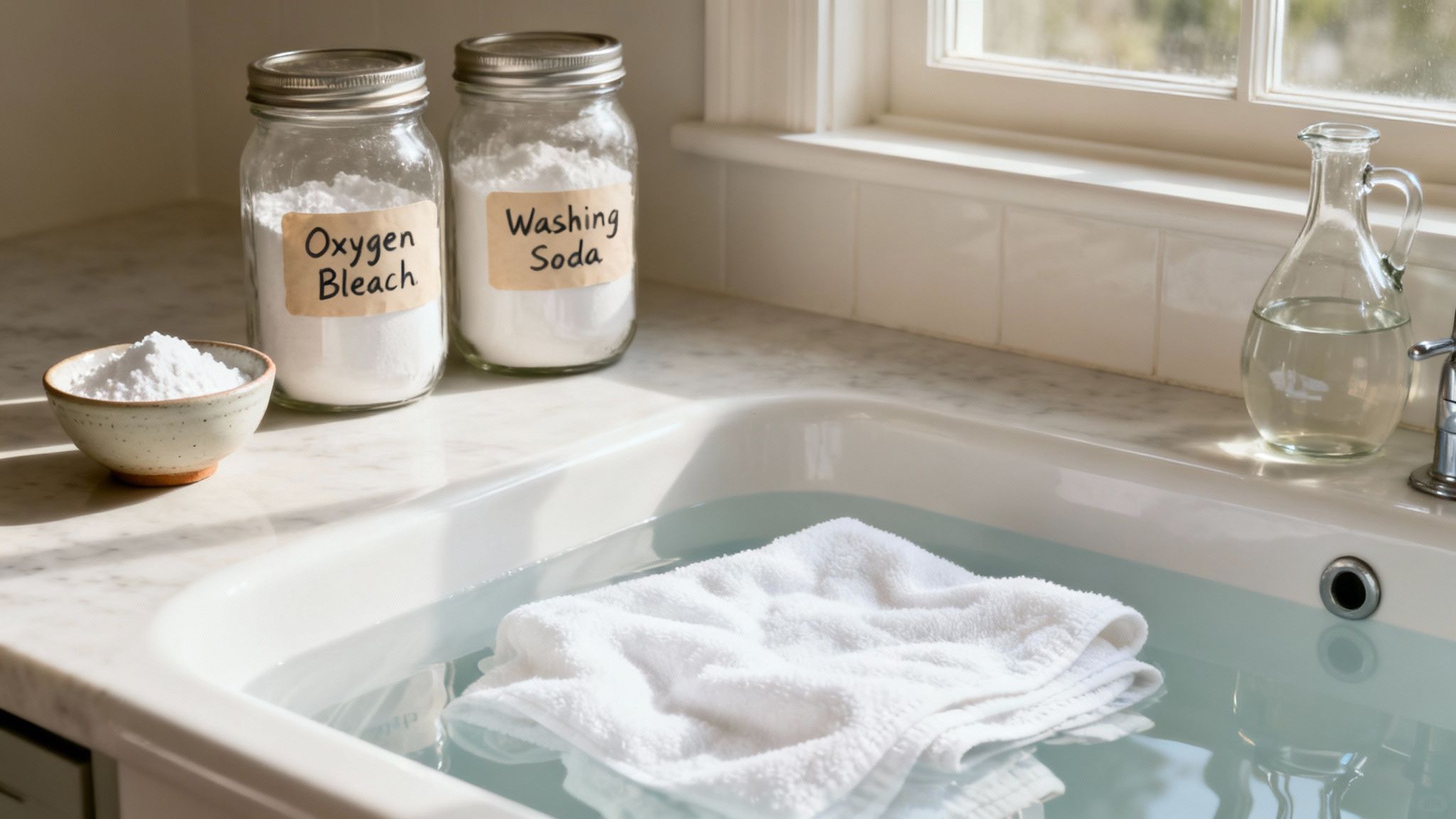
While the classic laundry stripping recipe is a total workhorse, I get it—not everyone is comfortable using Borax. Maybe you have sensitive skin in the house, or you just prefer to stick to a gentler routine.
The good news is you don't have to miss out. You can get a fantastic deep clean with alternative recipes that are just as powerful. These methods are my top recommendations for anyone looking for a more natural approach to banishing buildup.
One of the best borax-free swaps involves using an oxygen-based bleach. This switch still delivers that super satisfying, deep-down clean, especially for dingy whites and grimy stuff like kitchen towels or your kid's soccer uniform.
Powerful Borax-Free Soaking Recipe
For this method, you’re basically creating a powerhouse soak by combining washing soda with an oxygen brightener. It’s a fantastic way to break down all that stubborn residue, brighten whites, and tackle organic stains without reaching for harsh chlorine bleach.
Here’s the simple but mighty formula:
- 1/2 cup Washing Soda: This is the key to softening your water and raising the pH, creating the perfect alkaline environment to force out all that trapped gunk.
- 1/2 cup Oxygen-Based Bleach (like OxiClean): The magic here is sodium percarbonate. In hot water, it releases tiny oxygen bubbles that aggressively break apart stains and sanitize fabrics.
- 1/2 cup Powdered Laundry Detergent: You still need the surfactants in detergent to lift and carry away all the grime you’ve just loosened.
Just mix these into a bathtub of hot water, give it a good stir to dissolve everything, and add your laundry. Let it soak for four to six hours, stirring it every so often. Then, just toss the whole load into your machine for a final rinse-only cycle. You’ll be amazed at how refreshed your fabrics feel.
This borax-free recipe is my personal go-to for reviving bed pillows and white cotton sheets that have started to look a bit yellowed. The oxygen bleach works wonders at restoring their brightness.
A Gentler All-Natural Stripping Method
Need an even gentler option? If you’re dealing with baby clothes or delicate items, a simple combination of baking soda and vinegar can act as a mild stripping soak.
Now, this method won't give you that shocking, murky water you see with the stronger recipes. Think of it as more of a deep freshening soak. It’s excellent for neutralizing stubborn odors and softening fabrics by dissolving light mineral buildup.
For a full deep-dive on how these two pantry staples work their magic, you should check out our guide on washing clothes with baking soda and vinegar.
Ready to give it a try? It’s a simple two-step process:
- First, fill your tub with warm—not piping hot—water.
- Add one cup of baking soda and swish it around until it’s fully dissolved.
- Submerge your items and let them soak for at least a few hours.
- Finally, drain the tub and run the laundry through a rinse cycle in your washer. Add one cup of white vinegar to the fabric softener dispenser to finish the job.
The baking soda’s alkalinity helps loosen everything up, and the vinegar’s acidity comes in at the end to rinse it all away, leaving your clothes incredibly soft and fresh. Understanding what different cleaners do is key to getting great results. For instance, learning about non-soapy citrus cleaning solutions shows how different ingredients can tackle dirt in unique ways. These alternatives let you get that deep clean you’re after while sticking to a cleaning philosophy you feel good about.
Safely Stripping Colors and Delicate Fabrics

The very idea of dunking your favorite vibrant t-shirt or those pricey bed linens into a piping hot, intense cleaning bath can be a little nerve-wracking. A major reason people hesitate to try laundry stripping is the completely valid fear of causing irreversible damage—think color bleeding or fabrics literally falling apart.
But you don't have to ruin your clothes to get them truly clean. With a couple of smart precautions, you can strip away all that gross buildup without sacrificing your favorite items.
The absolute first and most important rule: always perform a colorfastness test before you even think about stripping a colored garment. This one simple step can save you a world of heartache. Just find a hidden spot, like an inside seam, dampen it, and press a clean white cloth against it for a few seconds. If any color comes off, that item is a hard "no" for stripping.
How to Tweak the Recipe for Colored Items
So, your colored items passed the colorfastness test. Great! You can go ahead, but with a slightly modified game plan. The intense heat in most stripping recipes is the main culprit behind fading dyes. To sidestep that risk, you just need to make two simple adjustments.
- Turn Down the Heat: Instead of using the hottest water your tap can possibly produce, just aim for warm water. It's still more than effective enough to open up the fabric's fibers and release grime, but it's much gentler on the dyes.
- Keep Colors Separate: This is Laundry 101, but it's even more critical here. Never, ever mix your lights and darks in a stripping bath. Keep similar color families together to prevent any sneaky dye transfer from ruining a whole batch of clothes.
With these minor tweaks, you can safely get the gunk out while keeping your colored fabrics looking vibrant.
Fabrics You Should Never, Ever Strip
While a good deep clean can work wonders on many textiles, some materials are just too delicate for the high heat and alkaline environment of a stripping solution. The process can permanently wreck their protein-based or synthetic fibers, causing them to shrink, warp, or lose their stretch for good.
Laundry stripping is a powerful tool, but it's definitely not a one-size-fits-all solution. Knowing which fabrics to avoid is just as important as knowing the recipe itself. Protecting delicate fibers from this intense process is key to maintaining their integrity and lifespan.
It’s crucial to know which materials need to stay out of the stripping tub. For a more detailed look at handling special materials, check out our guide on how to care for modern textiles.
Here’s a look at which fabrics are safe and which ones you should definitely skip.
Fabric Stripping Safety Guide
This quick table breaks down which fabrics can handle the stripping process and which ones are better left alone. Always double-check your garment's care tag first!
Always check the care tag before you start. When in doubt, it’s always better to play it safe and choose a gentler cleaning method for your treasured or delicate items.
Common Stripping Mistakes and How to Fix Them
Even with the best recipes, a few common slip-ups can stand between you and that deeply satisfying, murky-water clean. The good news? Most issues are simple to fix and often come down to small details in the process. Don’t worry—these are the mistakes we’ve all made at least once.
One of the most frequent errors is not letting the powders fully dissolve before adding your laundry. If you just dump everything in and immediately toss in your fabrics, you'll likely end up with a gritty, undissolved residue clinging to your clothes. This completely undermines the whole point, since the active ingredients can't work their magic if they're still in solid form.
The fix is simple: always add your Borax, washing soda, and detergent to the hot water first. Give it a good, vigorous stir with a long-handled spoon until you can see that every last granule has dissolved. Only then should you submerge your items.
Using the Wrong Type of Detergent
Another major pitfall is reaching for liquid detergent instead of powdered. It might seem like a minor substitution, but trust me, it makes a huge difference in your results.
Powdered detergents are formulated with special chemical "builders" that are specifically designed to soften water and supercharge the cleaning power of the other ingredients. Liquid detergents, on the other hand, typically lack these builders and just won't create the same powerful, alkaline solution needed to effectively break down and release all that stubborn buildup. Stick with a quality powdered formula to get that shockingly murky water and truly refreshed fabrics.
Key Takeaway: Whatever you do, don't skip the final rinse-only cycle. It's non-negotiable. Skipping it leaves behind a concentrated alkaline residue that can cause skin irritation and make fabrics feel stiff—the very problem you were trying to solve in the first place.
Overdoing It with Too-Frequent Stripping
It’s easy to get hooked on the dramatic results, but laundry stripping should be treated as a powerful, occasional reset, not a regular part of your laundry routine. Stripping fabrics too often—say, every month—can be pretty harsh on the fibers, leading to premature wear and tear.
For most things like towels and sheets, stripping them just two or three times per year is more than enough to keep them fresh, soft, and absorbent. Think of it as a seasonal deep clean rather than a weekly chore.
This targeted approach to deep cleaning is becoming more common in home care. The market for pre-treater laundry products, which tackle specific issues before a deep clean, was valued at USD 3,168.2 million in 2024 and is projected to hit USD 4,523.8 million by 2034. As people become more aware of product effectiveness, they're choosing specialized solutions like stripping for specific problems instead of overusing harsh methods all the time. You can explore more on the growth of specialized laundry solutions and see how consumer habits are changing the market.
Answering Your Top Laundry Stripping Questions
Jumping into laundry stripping for the first time can feel like a big step. It’s a pretty intense cleaning process, so it makes sense to have a few questions before you begin. Let's walk through some of the most common ones so you can feel totally confident when you start.
One of the first things people wonder about is how often they should be doing this. It's tempting to do it all the time once you see that murky water, but hold back!
How Often Should I Really Strip My Laundry?
Think of laundry stripping as a deep-cleansing facial for your fabrics—it’s a major reset, not an everyday thing. For those items that see a lot of action, like bath towels, kitchen cloths, and bed sheets, stripping them just two to three times per year is more than enough.
Going overboard can be tough on fabric fibers in the long run, and you might see them wear out faster than they should. The best way to know when it’s time? Just pay attention to your textiles. When you notice your towels aren't absorbing water like they used to, or your sheets just don't feel as crisp and clean, that's your cue.
Can I Use Liquid Detergent Instead?
This is a great question, and it comes up all the time. While it seems like an easy swap, you really need to stick with powdered detergent to get the job done right.
Here’s why: powdered detergents are packed with ingredients called "builders" (like sodium carbonate) that are specifically designed to soften hard water and seriously amp up cleaning power. They work in perfect harmony with the other ingredients in a stripping recipe. Liquid detergents just have a different chemical makeup and won't be nearly as effective at breaking down and lifting away that stubborn mineral and product buildup.
Laundry stripping is a powerful, alkaline process designed to remove everything—oils, heavy detergent residue, and minerals—all at once. A milder vinegar soak is great for regular maintenance and softening, but stripping is the tool you need for a major fabric restoration.
Is Laundry Stripping Safe for My Washing Machine?
For the most part, yes—but with a couple of important exceptions. The ingredients in laundry stripping recipes are perfectly safe for standard top-loading washing machines, which are built to handle long soaks.
However, you should never try to strip laundry in a front-loading High-Efficiency (HE) machine. These washers are marvels of modern engineering designed to use very little water. That's great for regular loads, but it completely prevents the deep, prolonged soaking that’s essential for a successful strip.
Once you're done stripping in a top-loader or bathtub, it's always a smart move to run an empty cycle with hot water. This will flush out any leftover residue from the machine itself, making sure it’s fresh and ready for your next regular load.
Tired of spending your weekends on deep-cleaning chores? Let Columbia Pike Laundry give you that "just stripped" freshness without any of the work. We handle the tough stuff so you can get back to what matters. Schedule your first pickup and reclaim your weekend.
Popular Blog Articles

Meet the Author
Daniel Logan didn’t start CPL because he loved laundry. He started it because his family was drowning in time debt, and laundry was one of the biggest weights.
Mornings were chaos with two kids under 5. Evenings felt like catch-up. And weekends? Gone to sorting socks and folding piles.
He knew his story wasn’t unique. So he built a business that gave families like his just a little bit of breathing room one load at a time.
With no laundry experience but deep tech skills, Daniel rolled up his sleeves, doing every job himself while building systems that turned it into a modern laundry service that saves customers time, simplifies their lives, and delivers reliability they can count on.
That’s where CPL began. Not from a playbook, but from pain. From one dad trying to buy back time: for himself, and for every household like his.


